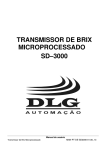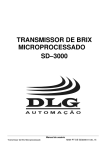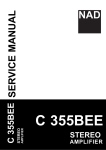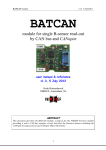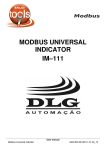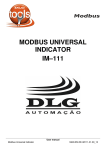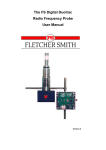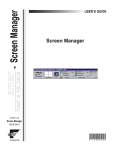Download MICROPROCESSOR- BASED BRIX TRANSMITTER SD–3000
Transcript
MICROPROCESSORBASED BRIX TRANSMITTER SD–3000 User Manual Microprocessor-based Brix Transmitter MAN-EN-DE-SD3000 Rev.: 1.00-11 Introduction Thank you for choosing our MICROPROCESSOR-BASED BRIX TRANSMITTER SD– 3000. To ensure its proper and efficient usage, it’s important to read this manual thoroughly to understand how to operate the SD–3000, before putting it into operation. About this Manual 1. This manual should be delivered to the end user of the SD–3000. 2. The contents of this manual are subject to change without notice. 3. All rights reserved. No part of this manual may be reproduced in any form without the written permission from DLG. 4. The specifications contained herein are limited to standard models and do not cover special products made by order. 5. All precautions were taken on preparing this manual, in order to guarantee the quality of its information. CAUTION! The instrument described in this technical user manual is a device suitable for application in a specialized technical area. DLG supplied products are submitted to a strict quality control process. However, industrial control electronic equipment can cause damage to machinery or processes controlled by them in the event of any failure or improper operations and may even endanger human lives. The user is responsible for setting and selecting values of the parameters of the instrument. The manufacturer warns of the risks of incidents with injuries to both people and goods, resulting from the incorrect use of the instrument. Contents INTRODUCTION............................................................................................ 3 CONTENTS ................................................................................................... 4 PRESENTATION ........................................................................................... 6 HOW TO SPECIFY ........................................................................................ 7 TYPICAL APPLICATIONS ............................................................................ 8 TECHNICAL SPECIFICATIONS.................................................................... 9 Input characteristics ............................................................................................ 9 Analog outputs characteristics ............................................................................ 9 General Characteristics .................................................................................... 10 DIMENSIONS .............................................................................................. 11 OPERATION................................................................................................ 12 Determining the Brix x Capacitance or Brix x Resistance curve................................ 13 INSTALLATION ........................................................................................... 14 Cable connection ...................................................................................................... 14 MECHANICAL INSTALLATION .................................................................. 16 SOFTWARE AND CONFIGURATION ......................................................... 17 Configuration ............................................................................................................. 20 Current Input ..................................................................................................... 20 Alarms .............................................................................................................. 22 Retransmission ................................................................................................. 24 Linearization ..................................................................................................... 26 Control .............................................................................................................. 27 Log.................................................................................................................... 28 Status Alarm.............................................................................................................. 30 Monitoring ................................................................................................................. 33 Trend ......................................................................................................................... 34 Communication ......................................................................................................... 35 Animation .................................................................................................................. 36 Configuring the Modbus RS-485 Communications Port ............................................ 37 MODBUS TABLE ........................................................................................ 39 Mask and Values for the Registers ........................................................................... 41 Read-only bits ................................................................................................... 41 Read/Write bits ................................................................................................. 42 Read/Write registers enumerations .................................................................. 43 Modbus relay activation and deactivation ................................................................. 45 Current channel engineering limits ............................................................................ 45 WARRANTY ................................................................................................ 46 NOTES ........................................................................................................ 47 SD–3000 MICROPROCESSOR-BASED BRIX TRANSMITTER Presentation The Microprocessor-based Brix Transmitter SD– 3000 transmits signals proportional to the Brix of a mixture in which the electrode is inserted, where Brix is the unit of measurement of soluble solids in sucrose solutions. The transmitter is applied in mass cooking process for production of sugar, among other applications. (note 1, page 8). It has a temperature measurement element (RTD) in direct contact with the system, eliminating the installation of another temperature transmitter. Using a modern technique of radio frequency, the SD–3000 provides two programmable analog signals: Xs and Rs, which are proportional to the capacitance and resistance of the cooked mass, respectively. Moreover, its design eliminates the need for cleaning the transmitter when it is used in batch cooking process, greatly increasing the interval between cleaning operations for continuous cooking. The sensing part is built in a 316 stainless steel casing and the electronic circuit is housed in aluminum housing, making it suitable for mounting on brackets and / or flanges, within the process. Page 6 of 48 User Manual SD-3000 Rev.: 1.00-11 All rights reserved to DLG Automação Industrial SD–3000 MICROPROCESSOR-BASED BRIX TRANSMITTER How to Specify SD–3000 / ____ - ___ Useful length for measurement (B+30+C) – see Figure 1: /L1 115 mm /L2 165 mm /L3 320 mm /E Special (specify) - ___ Without flange -F With flange User Manual SD-3000 Rev.: 1.00-11 All rights reserved to DLG Automação Industrial Page 7 of 48 SD–3000 MICROPROCESSOR-BASED BRIX TRANSMITTER Typical Applications Degree Brix measurement in liquors, dissolved sugar, sugar massecuite A, B and C. Note 1: other applications on request. Page 8 of 48 User Manual SD-3000 Rev.: 1.00-11 All rights reserved to DLG Automação Industrial SD–3000 MICROPROCESSOR-BASED BRIX TRANSMITTER Technical Specifications Input characteristics Type Parameter Brix Rod temp. Current 10 DC current 0 ~ 20 4 ~ 20 ± 0.5 Pt 0,1 0,1 Current Input signal Input impedance A/D precision (FS) Linearization Min. 0 4 50 0 Degree Brix Probe temp. Degree Brix PT-100 Max. 20 20 95 130 Comments Unit mA @27MHz RTD Bx ºC Ω ±1 ±1 uA ± 0,1 % ºC % ºC Analog outputs characteristics Output Type Range Resolution Output Impedance Current Current 0 ~ 20 mA 4 ~ 20 mA 4,8 uA 4,8 uA 750Ω max 750Ω max User Manual SD-3000 Rev.: 1.00-11 All rights reserved to DLG Automação Industrial Page 9 of 48 SD–3000 MICROPROCESSOR-BASED BRIX TRANSMITTER General Characteristics Parameter Power consumption Input voltage Operating frequency IP protection Scan time Scale Modbus timeout Alarms Xs and Rs linearization Communication Electronic unit operating temperature Thermal stability Relative humidity Construction Placement Electrical connection Aprox. weight Sampling time Page 10 of 48 Characteristics 7,2 W 24 Vdc 27MHz IP–65 150 ms –30000 a +30000 in engineering units Adjustable from 3 ms to 60 ms (3 ms multiples) 2 alarms, with 2 solid state relay outputs: max 240 Vca; 130 mA ca; Isol. 3750 Vca 50 interpolation points 2 RS-485 ports, with 1500 V isolation and transient protection filter Configurable even, odd or no parity Baud rates (bps): 9600, 19200, 38400, 57600 and 115200 Modbus RTU protocol 0 ºC - 75 ºC ±0,005% / °C span @ 25°C. Up to 90% Aluminum housing AISI-316 stainless steel rod Polyamide dielectric 6.6 Fast clamping connection flange 22AWG wire with fast clamping connectors 3 kg 6 samples per second User Manual SD-3000 Rev.: 1.00-11 All rights reserved to DLG Automação Industrial SD–3000 MICROPROCESSOR-BASED BRIX TRANSMITTER Dimensions Figure 1 – Scaling mount (dimensions in mm) Dimensions A (mm) B (mm) C (mm) SD-3000/L1 300 40 45 SD-3000/L2 350 90 45 SD-3000/L3 505 90 200 User Manual SD-3000 Rev.: 1.00-11 All rights reserved to DLG Automação Industrial Page 11 of 48 SD–3000 MICROPROCESSOR-BASED BRIX TRANSMITTER Operation The SD–3000 transmitter measures the Brix of the product around its contact area, based on electrical principles. The electrical characteristics of a product depends on several factors, including the Brix. Thus, measuring the difficulty of an electrical signal to go through the mass, it is possible to determine the degree Brix. The SD–3000 is an instrument that measures two electrical quantities, resistance and capacitance. The RS channel is proportional to the resistance and the other channel, XS, is proportional to the capacitance. The two channels can be used in control applications. However, experience shows that the channel XS is more immune to variations of impurities. Figure 2 – SD-3000 operation. Note: illustrative figure which may differ according to the process. The transmitter channels obey a linear variation with the resistance and capacitance, but these quantities do not obey a linear function when compared with the degree Brix. The SD–3000 is able to linearize this curve to indicate the value in Brix and its main characteristic is repeatability. The most important feature is the repeatability, i.e., if a specific control operation point in a process has a specific current in mA (in resistance or capacitance), this value will be repeatable and may be used always in the process, including other batches. The SD–3000 performs linearization in order to estimate the Brix. A specific linearization must not be used in other processes different than the one that was used to calculate the linearization parameters. Once a specific linearization RS x Brix or XS x Brix is obtained few changes should occur in the process. Page 12 of 48 User Manual SD-3000 Rev.: 1.00-11 All rights reserved to DLG Automação Industrial SD–3000 MICROPROCESSOR-BASED BRIX TRANSMITTER Determining the Brix x Capacitance or Brix x Resistance curve The SD–3000 has two signal linearization tables, with 50 points each. Using this feature, we can estimate the Brix of the measured mass. Therefore, it is necessary to use a precision refractometer as reference for the sample. Initially, a table must be created. This table must have annotations of the RS, XS and Brix values. The DLGTools software has this feature which automates the linearization process (see Software and configuration Configuration LOG). Start collecting mass samples and at the moment the sample is collected, record the value of channels RS and XS. Keep the sample and measure its Brix in the refractometer. Repeat this step for different values of Brix. Once the table is filled, a linearization curve is determined. Some care must be taken when the samples are collected: • The sample should be collected as close as possible to the SD–3000 transmitter; • Before collecting the sample, check whether there is a significant variation in the RS and/or XS channels; • Make sure that the collected sample represents the product that is being analyzed by the SD–3000 transmitter; • Take special care with the collecting pipes. They can accumulate products that may be contaminated or accumulate products from previous samples, which can invalidate the sampling process; • Pay attention to the sample collecting time. It is good practice to use the values of XS and RS only after the sample is collected; • It is also recommended to repeat this procedure three times, in order to eliminate discrepancies. User Manual SD-3000 Rev.: 1.00-11 All rights reserved to DLG Automação Industrial Page 13 of 48 SD–3000 MICROPROCESSOR-BASED BRIX TRANSMITTER Installation Cable connection Pin 1 2 3 4 5 6 7 8 Page 14 of 48 CN1 Function Positive, current input Negative, current input Positive, RS-485 communication port 1 Negative, RS-485 communication port 1 Shield, RS-485 communication port 1 Positive, current output 1 GND current outputs 1 and 2 Positive, current output 2 Cable color Red Light Brown Blue Grey Green Yellow Dark Brown White User Manual SD-3000 Rev.: 1.00-11 All rights reserved to DLG Automação Industrial SD–3000 MICROPROCESSOR-BASED BRIX TRANSMITTER CN2 Function Pin 1 2 3 4 5 6 7 8 Power +24Vdc Power GND Housing GND Normally open (NO) output relay 1 Common relay 1 Normally open (NO) output relay 2 Common relay 2 Not used Cable color Red Light Brown Green Blue Grey Yellow White - Pin 1 2 3 4 5 CN3 Function Output (HMI) Power +24Vdc Output (HMI) Power GND Positive, RS-485 communication port 2 Negative, RS-485 communication port 2 Shield RS-485 communication port 2 Color cable Red Black Blue White Dark Brown User Manual SD-3000 Rev.: 1.00-11 All rights reserved to DLG Automação Industrial Page 15 of 48 SD–3000 MICROPROCESSOR-BASED BRIX TRANSMITTER Mechanical Installation The SD–3000 must be installed directly to the process in which Brix measurement is to done. In baking pans (sugar manufacturing) the SD–3000 must be installed underneath or on the side taking care to install it in a location where it is ensured that the transmitter will measure a homogeneous mass. It is recommended to keep a distance of 0.5 m between the SD–3000 and any metal parts (including paddle stirrer if any). This ensures that the measurement principle of the transmitter will not be influenced by proximity to metal parts. The SD–3000 should never be installed above the calender or where there is the possibility of bubble formation that may cause errors in measurement. *Figure 3 - Transmitter position in sugar cooking pot (vaccum) *Note: Figure 3 is an illustrative example, not having a real scale. Page 16 of 48 User Manual SD-3000 Rev.: 1.00-11 All rights reserved to DLG Automação Industrial SD–3000 MICROPROCESSOR-BASED BRIX TRANSMITTER Software and Configuration *Note: Before configuring the SD–3000, make sure that the equipment has been operating for approximately 20 minutes. The SD–3000 is configured by DLGTools. After DLGTools is opened, click in the icon devices in the Modbus network. ONLINE/OFFLINE to find the SD–3000 User Manual SD-3000 Rev.: 1.00-11 All rights reserved to DLG Automação Industrial Page 17 of 48 SD–3000 MICROPROCESSOR-BASED BRIX TRANSMITTER Select the correct SD–3000 and click in from the SD–3000. Page 18 of 48 . DLGTools will upload all parameters User Manual SD-3000 Rev.: 1.00-11 All rights reserved to DLG Automação Industrial SD–3000 MICROPROCESSOR-BASED BRIX TRANSMITTER In the configuration screen it is possible to parameterize all SD–3000 registers. The DLG Tools Explorer window can select all the configuration and operation functions of the SD–3000. Configuration: Configure all SD–3000 parameters, as current inputs, alarms, retransmission, linearization, control and sample logs; Status Alarm: Monitors the alarm statuses and whether the output relays are triggered or not; Monitoring: Monitors all SD–3000 Modbus registers, automatically or manually; Trend: Display the XS, RS, linearized XS, linearized RS, temperatures, current input, rod temperature and internal temperature. Communication: Display RS-485 port configuration parameters and the UPLOAD and DOWNLOAD commands. Animation: Graphical resources for representing the inputs. User Manual SD-3000 Rev.: 1.00-11 All rights reserved to DLG Automação Industrial Page 19 of 48 SD–3000 MICROPROCESSOR-BASED BRIX TRANSMITTER Configuration Current Input Page 20 of 48 User Manual SD-3000 Rev.: 1.00-11 All rights reserved to DLG Automação Industrial SD–3000 MICROPROCESSOR-BASED BRIX TRANSMITTER Parameters: • Offset: Adds an offset value to the value read from the current input. Example: If the reading is 10.00 and the offset is 1.00 then the value shown in the channel will be 10.00 + 1.00 = 11:00 • Decimal Point: Determines the number of places after the comma, and may be from 0 up to 3. Example: 10.000, 10.00, 10.0 ou 10. • Un Eng Max: Determines what will be the value displayed in the current channel when the input is equal to 20 mA. • Un Eng Min: Determines what will be the value displayed in the current channel when the input is equal to 0 mA. The configuration parameters for the current input determine which value will be displayed in the current channel. Example: Offset Decimal Point Un Eng Max. Un Eng Min. = 1,00 =2 = 30.00 = 3,00 When the input is 10 mA, the indication will be 16.50. User Manual SD-3000 Rev.: 1.00-11 All rights reserved to DLG Automação Industrial Page 21 of 48 SD–3000 MICROPROCESSOR-BASED BRIX TRANSMITTER Alarms Parameters: • Variable: Defines which variable will be associated to alarm 1 or 2. The possible variables are: Page 22 of 48 XS; RS; Linearized XS; Linearized RS; Current Input; Rod temperature. User Manual SD-3000 Rev.: 1.00-11 All rights reserved to DLG Automação Industrial SD–3000 MICROPROCESSOR-BASED BRIX TRANSMITTER • Alarm Condition: Defines which the condition mode of alarms 1 and 2 is. The possible modes are: • Value of Low: operates when the input value falls below the Set Point. Valor of High: operates when the input value goes above the Set Point. Differential: operates when the input value lies outside the range defined by Set Point and Hysteresis, where Set Point is the center of the range and Hysteresis defines its upper and lower limits. Inverted Differential: operates when the input value lies inside the range defined by Set Point and Hysteresis, where Set Point is the center of the range and Hysteresis defines its upper and lower limits. Inoperative: disables the alarm. Hysteresis: For each alarm condition type Hysteresis has a different function: Value of Low: Hysteresis defines an offset to disable the alarm. The alarm will be disabled when the input value is greater than the Set Point plus Hysteresis. Value of High: Hysteresis defines an offset to disable the alarm. The alarm will be disabled when the input value is less than the Set Point plus Hysteresis. Differential: Hysteresis defines high and low limits for alarm operation. Set Point is the center of the range and Hysteresis defines upper and lower limits. Example: Set Point 5.00 and Hysteresis 1.00 defines a range from 4.00 to 6.00, and the alarm is enabled when the input value is OUTSIDE this range. Inverted Differential: Hysteresis defines high and low limits for alarm operation. Set Point is the center of the range and Hysteresis defines upper and lower limits. Example: Set Point 5.00 and Hysteresis 1.00 defines a range from 4.00 to 6.00, and the alarm is enabled when the input value is INSIDE this range. • Time Delay: Sets a timer to enable the alarm. If the input is within the alarm range the timer is triggered and when the specified time elapses the alarm will be enabled. If the input value leaves the alarm range the timer will reset and will trigger again when the input value lies inside the alarm range. • Set Point: Reference value for alarm activation. • Select Relay: Defines which relay will be activated by the alarm. User Manual SD-3000 Rev.: 1.00-11 All rights reserved to DLG Automação Industrial Page 23 of 48 SD–3000 MICROPROCESSOR-BASED BRIX TRANSMITTER Retransmission Parameters: • Variable: This parameter defines which variable will be associated with retransmission 1 or 2. The possible variables are: Page 24 of 48 XS; RS; Linearized XS; Linearized RS; Current channel; Rod temperature. User Manual SD-3000 Rev.: 1.00-11 All rights reserved to DLG Automação Industrial SD–3000 MICROPROCESSOR-BASED BRIX TRANSMITTER • Output Range: Defines the retransmission ranges: 0 ~ 20 mA and 0 ~ 10 Volts 4 ~ 20 mA and 2 ~ 10 Volts • Scale: Defines the scales associated with retransmission: Engineering: uses Un Max Eng and Un Min Eng as retransmission limits. Only Current channel and Rod temperature can be selected in this case. Example: if the current channel is being retransmitted and the configured engineering units are from 0.00 to 30.00 then input 0.00 is retransmitted as 0 mA (or 4 mA) and input 30.00 is retransmitted as 20 mA. Limit: uses the configured limits (High Limit and Low Limit) for retransmission. Any channel may be selected. Example: if the current channel is being retransmitted and the configured engineering units are from 0.00 to 30.00, and the configured limits are from 10.00 to 20.00, then input 10.00 is retransmitted as 0 mA (or 4 mA) and input 20.00 is retransmitted as 20 mA. The output is limited to the selected range keeping proportionality with the input. User Manual SD-3000 Rev.: 1.00-11 All rights reserved to DLG Automação Industrial Page 25 of 48 SD–3000 MICROPROCESSOR-BASED BRIX TRANSMITTER Linearization The SD–3000 has 2 linearization tables (XS and RS), with 50 points each. Linearization is enabled when bit 1 from the SD–3000 control register (address 40035) is set. The number of linearization steps should be chosen as follows: 1 - Edit columns LINI_ and LINO_ inserting the desired number of rows. 2 - After the last row LININ_ and LINO_ must be zero. 3 - The first LINI_ value is not editable and is always zero. 4 - LINI_ values cannot lie outside the RS (0 to 15000) and XS (0 to 1500) limits. Page 26 of 48 User Manual SD-3000 Rev.: 1.00-11 All rights reserved to DLG Automação Industrial SD–3000 MICROPROCESSOR-BASED BRIX TRANSMITTER Control Parameters: • XS Goal: Set point value relative to the phase difference in which the SD–3000 has constant control. • Phase Filter: Filter value applied to the SD–3000 phase control signal. • Phase Error: Maximum error allowed to phase control considering the set point value fixed in XS Goal. User Manual SD-3000 Rev.: 1.00-11 All rights reserved to DLG Automação Industrial Page 27 of 48 SD–3000 MICROPROCESSOR-BASED BRIX TRANSMITTER Log This feature is useful to create a linearization table, with the samples measured in a laboratory. • • • • • Page 28 of 48 Collect the sample and click in . Put an identification number on the sample and in the TAG column in the table. Send the sample to the laboratory. After receiving the results from the laboratory fill the table. Repeat this step for the number of samples wanted. User Manual SD-3000 Rev.: 1.00-11 All rights reserved to DLG Automação Industrial SD–3000 MICROPROCESSOR-BASED BRIX TRANSMITTER To create a new file: • • Click in . Give a name to the file and save it. To use an existent file: • Click in • Selected the file and click in . (Open). It is possible to export data to Microsoft Excel, clicking in name to the new file. User Manual SD-3000 Rev.: 1.00-11 All rights reserved to DLG Automação Industrial and selecting a Page 29 of 48 SD–3000 MICROPROCESSOR-BASED BRIX TRANSMITTER Status Alarm This feature allows monitoring of the relay activation statuses, based on the alarm configuration. It is also possible to reset or force the relay activation. Page 30 of 48 User Manual SD-3000 Rev.: 1.00-11 All rights reserved to DLG Automação Industrial SD–3000 MICROPROCESSOR-BASED BRIX TRANSMITTER This feature allows monitoring the alarm activation statuses. User Manual SD-3000 Rev.: 1.00-11 All rights reserved to DLG Automação Industrial Page 31 of 48 SD–3000 MICROPROCESSOR-BASED BRIX TRANSMITTER This feature allows monitoring the transmitter statuses. Page 32 of 48 User Manual SD-3000 Rev.: 1.00-11 All rights reserved to DLG Automação Industrial SD–3000 MICROPROCESSOR-BASED BRIX TRANSMITTER Monitoring This feature monitors the whole Modbus table, manually or automatically. By clicking in the Modbus table is scanned once. By clicking in the table is scanned continuously, with period defined in Tools > Communication > Scan > Scan Period. The scan period can be from 0.1 to 5 seconds. To stop scanning, click in . Data can be exported to Microsoft Excel by clicking in name to the new file. User Manual SD-3000 Rev.: 1.00-11 All rights reserved to DLG Automação Industrial and defining a Page 33 of 48 SD–3000 MICROPROCESSOR-BASED BRIX TRANSMITTER Trend This feature displays a graphical representation of the SD–3000 inputs. • Set the sampling time, which can be specified in: • Click in • Click in Page 34 of 48 Minutes Hours Days and create a new file or open an existent one. . User Manual SD-3000 Rev.: 1.00-11 All rights reserved to DLG Automação Industrial SD–3000 MICROPROCESSOR-BASED BRIX TRANSMITTER Communication This feature uploads the SD-3000 registers to DLGTools or downloads the DLGTools registers to the SD-3000. • Status Communication: Port Connected: indicates to which RS-485 port in the SD-3000 that DLGTools is connected to. Status Port: indicates if the port is in NORMAL or RESET mode. Port last write: indicates which SD-3000 port last received configuration parameters. • Current Parameters Port 1 and 2: indicates how the RS-485 ports are configured. User Manual SD-3000 Rev.: 1.00-11 All rights reserved to DLG Automação Industrial Page 35 of 48 SD–3000 MICROPROCESSOR-BASED BRIX TRANSMITTER Animation This feature allows animating all analog registers from the Modbus table using graphical objects. Page 36 of 48 User Manual SD-3000 Rev.: 1.00-11 All rights reserved to DLG Automação Industrial SD–3000 MICROPROCESSOR-BASED BRIX TRANSMITTER Configuring the Modbus RS-485 Communications Port In the device search screen, DLGTools can configure the RS-485 communications port parameters of the DLG devices. User Manual SD-3000 Rev.: 1.00-11 All rights reserved to DLG Automação Industrial Page 37 of 48 SD–3000 MICROPROCESSOR-BASED BRIX TRANSMITTER Clicking over the desired device and then in , the communications configuration screen will be opened. In this screen it is possible to configure: • ID: this is the device Modbus address, ranging from 1 to 255. • Baud Rate: Defines the baud rate, which can be: 9600, 19200, 38400, 57600 or 115200 bps. • Paridade: Defines how parity checking is done: even parity, odd parity or no parity. • Atraso resposta: Defines a delay between the equipment receiving the Modbus request and sending the Modbus response. The delay can range from 10 ms to 100 ms. After the parameters are set, click in Page 38 of 48 to send them to the SD–3000. User Manual SD-3000 Rev.: 1.00-11 All rights reserved to DLG Automação Industrial SD–3000 MICROPROCESSOR-BASED BRIX TRANSMITTER CA CM CXSV CRSV CXSL CRSL CCor TEMP STA RES STR STS TEMPI RSA RESERVED Goal channel XS channel volts RS channel volts XS channel linearized RS channel linearized Current channel PT100 temperature Alarm status RESERVED Relay status Transmitter status Internal temperature Alarm reset 0 0x0F Min Mnemonic 0 1 2 3 4 5 6 7 8 9 10 11 12 13 Description Max Offset 40001 40002 40003 40004 40005 40006 40007 40008 40009 40010 40011 40012 40013 40014 Limits Default Address Modbus Table T y p e Read/ WriteRetentive /NonRetentive R R R R R R R R R R R R R 0 US SS SS SS SS SS SS US US US US US SS US R/W NR Communications Configuration 40015 40016 40017 40018 40019 40020 40021 14 15 16 17 18 19 20 END BRC1 PARC1 TOUTC1 BRC2 PARC2 TOUTC2 Address Channel 1 baud rate Channel 1 parity Channel 1 timeout Channel 2 baud rate Channel 2 parity Channel 2 timeout 1 4 2 10 4 2 10 247 7 2 100 7 2 100 0 3 0 10 3 0 10 US US US US US US US R/W R/W R/W R/W R/W R/W R/W R R R R R R R 0 20000 0 3 30000 30000 30000 4 -30000 -30000 -30000 0 SS SS SS US R/W R/W R/W R/W R R R R Engineering 40022 40023 40024 40025 21 22 23 24 OSETMA ENGH ENGL PDMA mA Offset Engineering High MA Engineering Low MA Decimal point MA User Manual SD-3000 Rev.: 1.00-11 All rights reserved to DLG Automação Industrial Page 39 of 48 SD–3000 MICROPROCESSOR-BASED BRIX TRANSMITTER Alarm Configuration 40026 40027 40028 40029 40030 40031 40032 40033 40034 25 26 27 28 29 30 31 32 33 CTRLA CAL DAL1 DAL2 HAL1 HAL2 SPAL1 SPAL2 MASRL Alarm control Alarm condition Alarm 1 delay Alarm 2 delay Alarm 1 hysteresis Alarm 2 hysteresis Alarm 1 set point Alarm 2 set point Alarm relay mask 0x55 0 0 0 0 0 0 0 0 0x2000 0 US 0x44 0 US 10 0 US 10 0 US 30000 0 US 30000 0 US 30000 -30000 SS 30000 -30000 SS 0x0F 0 US R/W R/W R/W R/W R/W R/W R/W R/W R/W R R R R R R R R R 0x0F 0x2000 30000 30000 30000 30000 R/W R/W R/W R/W R/W R/W R R R R R R Retransmission Configuration 40035 40036 40037 40038 40039 40040 40041 40042 34 35 36 37 38 39 40 41 TRET CRET LRLXS LRHXS LRLRS LRHRS Retransmission type Retransmission channel CH1 low retransmission limit CH1 high retransmission limit CH2 low retransmission limit CH2 high retransmission limit RESERVED RESERVED 0 0x55 0 0 0 0 0 0 0 0 0 0 US US SS SS SS SS Linearization Tables 40043 40093 40143 40193 40243 40244 40245 40246 40247 40248 40249 40250 40251 42-91 92141 142191 192241 242 243 244 245 246 247 248 249 250 XS output value for LINOXS0i linearization point i XS input value for linearization LINIXS01 point i RS output value for LINORS01 linearization point i RS input value for linearization LINIRS01 point i CTRL SD3000 control TMASS MXS DA1 DA2 DA3 DA4 FILD ERRD US = Unsigned Short W = Write Page 40 of 48 0 30000 0 30000 0 30000 0 30000 0 SS R/W R 0 0x0F 0 US R/W R 0 0 0 0 0 0 0 0 US US US US US US US US R/W R/W R/W R/W R/W R/W R/W R/W Calibrations (password needed) Mass type 0 0x7FFF Goal XS 0 15000 DA1 1000 1500 DA2 0 1500 DA3 937 1500 DA4 600 1500 Phase Drift Filter 30 100 Phase Drift Error 30 100 SS = Signed Short R = Retentive -30000 SS 0 SS R/W R -30000 SS R/W R R = Read NR = Non-retentive User Manual SD-3000 Rev.: 1.00-11 All rights reserved to DLG Automação Industrial R/W R R R R R R R R R SD–3000 MICROPROCESSOR-BASED BRIX TRANSMITTER Mask and Values for the Registers Read-only bits Bit 0 1 Function Alarm status - 40009 Alarm 1 Alarm 2 Comments 0 = Deactivated 1 = Activated Relay status – 40011 0 1 8 9 10 11 12 13 0 1 2 3 4 5 6 7 8 9 Relay 1 0 = Deactivated 1 = Activated Relay 2 Alarm 1 activated relay 1 Alarm 1 activated relay 2 Alarm 2 activated relay 1 0 = False 1 = True Alarm 2 activated relay 2 Modbus activated relay 1 Modbus activated relay 2 Transmitter status – 40012 PROBE_LOCK PROBE_CONTROL_OFF PROBE_DEF_MINOR PROBE_DEF_MAJOR 0 = Deactivated PROBE_LOOP 1 = Activated RESERVED CS5524 ERROR EEPROM_ERROR LINEARIZATION_ERROR PASSWORD FEEDBACK User Manual SD-3000 Rev.: 1.00-11 All rights reserved to DLG Automação Industrial Page 41 of 48 SD–3000 MICROPROCESSOR-BASED BRIX TRANSMITTER Read/Write bits Bit 0 1 2 3 0 1 2 3 0 1 Page 42 of 48 Comments Function Relay activation/deactivation – 40014 Deactivate relay 1 0 = No action 1 = Deactivates relay Deactivate relay 2 Activate relay 1 0 = No action 1 = Activates relay Activate relay 2 Alarm 1 and 2 masks – 40034 Alarm 1 relay 1 0 = Relay not associated with Alarm 1 relay 2 alarm Alarm 2 relay 1 1 = Relay associated with alarm Alarm 2 relay 2 Control – 40243 0 = Enables control XS control 1 = Disables control 0 = Disables linearization Linearization 1 = Enables linearization User Manual SD-3000 Rev.: 1.00-11 All rights reserved to DLG Automação Industrial SD–3000 MICROPROCESSOR-BASED BRIX TRANSMITTER Read/Write registers enumerations Value 3 4 5 6 7 Comments Function Baud rate – 40016 and 40019 9600 19200 38400 57600 115200 Parity – 40017 and 40020 0 1 2 Even Odd None Alarm type – 40026 0x00 0x01 0x02 0x03 0x04 0x05 0x06 0x10 0x20 0x30 0x40 0x50 0x60 Disabled XS channel RS channel Linearized XS channel Linearized RS channel Current channel PT100 temperature XS channel RS channel Linearized XS channel Linearized RS channel Current channel PT100 temperature Alarm type 1 The register value must be the sum of “alarm type 1” and “alarm type 2”. Alarm type 2 The register value must be the sum of “alarm type 1” and “alarm type 2”. Alarm condition – 40027 0 1 2 3 4 0 8 16 24 32 Minimum value Maximum value Differential Differential inverted Disabled Minimum value Maximum value Differential Differential inverted Disabled Alarm condition 1 The register value must be the sum of “alarm condition 1” and “alarm condition 2”. Alarm condition 2 The register value must be the sum of “alarm condition 1” and “alarm condition 2”. User Manual SD-3000 Rev.: 1.00-11 All rights reserved to DLG Automação Industrial Page 43 of 48 SD–3000 MICROPROCESSOR-BASED BRIX TRANSMITTER 0x00 0x01 0x02 0x03 0x00 0x10 0x20 0x30 0x00 0x01 0x02 0x03 0x04 0x05 0x06 0x10 0x20 0x30 0x40 0x50 0x60 0 1 2 Page 44 of 48 PV retransmission type – 40035 0 – 20 mA or 0 – 10 V retransmission based on span and engineering zero 0 – 20 mA or 0 – 10 V retransmission based on minimum and maximum limits 4 – 20 mA or 2 – 10 V retransmission based on span and engineering zero 4 – 20 mA or 2 – 10 V retransmission based on minimum and maximum limits 0 – 20 mA or 0 – 10 V retransmission based on span and engineering zero 0 – 20 mA or 0 – 10 V retransmission based on minimum and maximum limits 4 – 20 mA or 2 – 10 V retransmission based on span and engineering zero 4 – 20 mA or 2 – 10 V retransmission based on minimum and maximum limits Retransmitted channel – 40036 Disabled XS channel RS channel Linearized XS channel Linearized RS channel Current channel PT100 temperature XS channel RS channel Linearized XS channel Linearized RS channel Current channel PT100 temperature Mass type – 40244 A or B mass Free Calibration Retransmission type 1 The register value must be the sum of “retransmission type 1” and “retransmission type 2”. Retransmission type 2 The register value must be the sum of “retransmission type 1” and “retransmission type 2”. Retransmitted channel 1 The register value must be the sum of “retransmitted channel 1” and “retransmitted channel 2”. Retransmitted channel 2 The register value must be the sum of “retransmitted channel 1” and “retransmitted channel 2”. User Manual SD-3000 Rev.: 1.00-11 All rights reserved to DLG Automação Industrial SD–3000 MICROPROCESSOR-BASED BRIX TRANSMITTER Modbus relay activation and deactivation Relay activation/deactivation - 40014 Value Action 1 Deactivate relay 1 2 Deactivate relay 2 4 Activate relay 1 8 Activate relay 2 If the transmitter receives an activation and deactivation request for the same relay, only the deactivation request is processed. It is only possible to activate or deactivate a relay from a Modbus request only if the relay is not associated with an alarm, otherwise the request is discarded. Current channel engineering limits The SD–3000 transmitter has a current input channel that may be used for any purpose and its engineering limits are described below: Channel Current Eng Max 30000 Eng Min -30000 Comments Configurable by the current input User Manual SD-3000 Rev.: 1.00-11 All rights reserved to DLG Automação Industrial Page 45 of 48 SD–3000 MICROPROCESSOR-BASED BRIX TRANSMITTER Warranty The manufacturer assures to the equipment owners, identified by the purchase invoice, warranty of 1 (one) year as follows: 1 - The warranty period begins on the data of the invoice issue. 2- Within the warranty period, the labor and parts used for repairing damage occurred in normal use are free. 3- For repairs, send the equipment along with the shipping invoices to our factory in Sertãozinho, São Paulo state, Brazil. DLG’s address is available at the end of this manual. 4 - The owner is responsible for transportation costs and risks. 5- Warranty will be automatically suspended if changed are made to the equipment by personnel not authorized by DLG, defects caused by mechanical shock, exposure to conditions unfit for use or tampering with the product. 6- DLG disclaims any charge relating to unauthorized repairs or replacements due to failures caused by agents external to the equipment, the improper use of them and as a result of unforeseeable circumstances or major forces. 7- The DLG ensures full operation of the equipment described herein and all existing operations. Page 46 of 48 User Manual SD-3000 Rev.: 1.00-11 All rights reserved to DLG Automação Industrial Notes DLG Automação Industrial Ltda. Rua José Batista Soares, 53 Distrito industrial – 14176-119 Sertãozinho – São Paulo – Brasil Fone: +55-16-3513-7400 www.dlg.com.br Rev: 1.00-11 MICROPROCESSOR-BASED BRIX TRANSMITTER SD–3000 DLG reserves the right to change this manual contents without notice in order to keep updating it with potential product developments.
















































